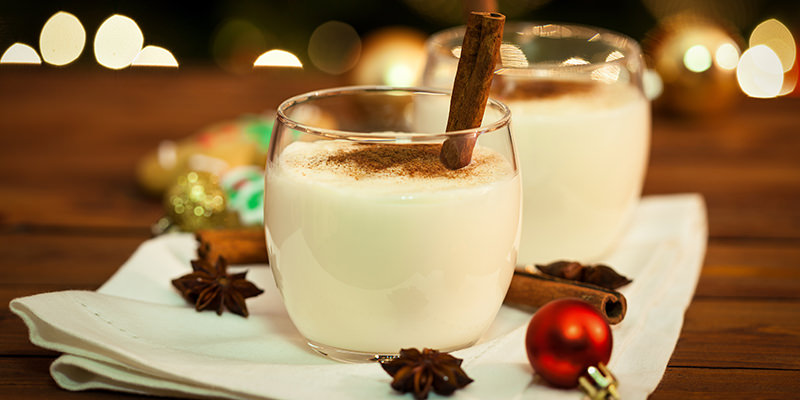It’s the most wonderful, or terrible, time of the year. Because everybody’s favorite (or least favorite) calorie-packed, viscous seasonal beverage has made its annual, puddy yellow return. That’s right, y’all. It’s ‘nog time.
Before you reach for that carton of Southern Comfort—or maybe you’re a Turkey Hill loyalist—and whisper “Hello, old friend,” maybe take a second to review exactly how much you know about the milky yellow stuff. Sure, it seems friendly enough, something to sip on while trying to make sense of White Christmas. But before you put on your holiday Snuggie and knock back 200 calories of what’s essentially melted ice cream, here are a few things you may not have known about your (least) favorite seasonal drink.
You Can Make It At Home
Most of us (who admit to liking the stuff) buy it by the carton, or gallon jug if it’s been a real tough week. But making eggnog at home is an adventure, fully worth trying—though only if you’re comfortable around large quantities of liquor and raw eggs. Some recipes, like Alton Brown’s, make smaller quantities—6 to 7 cups—with a small amount of liquor—3 ounces of bourbon (he also has a cooked option). If you wanna go hedonistic whole hog, try The Joy of Cooking recipe. There’s a dozen eggs, a pound of confectioner’s sugar, and 4 to 6 cups of rum. Oh, and lots of cream.
George Washington Made It At Home
If you need any more reason to give eggnog a chance, just look to the father of our country. Washington loved him some eggnog, and even had his own recipe, which, unfortunately, doesn’t specify the quantity of eggs. But guess right (or even close to right), and you’re drinking like everybody’s favorite founding father.
One quart cream, one quart milk, one dozen tablespoons sugar, one pint brandy, ½ pint rye whiskey, ½ pint Jamaica rum, ¼ pint sherry—mix liquor first, then separate yolks and whites of eggs, add sugar to beaten yolks, mix well. Add milk and cream, slowly beating. Beat whites of eggs until stiff and fold slowly into mixture. Let set in cool place for several days. Taste frequently.
Hell yeah, Washington. We will taste frequently.
There Is Some Serious FDA Egg Nog Regulation
“The name of the food is eggnog. The name of the food shall be accompanied by a declaration indicating the presence of any characterizing flavoring as specified in 101.22 of this chapter.” Sheer poetry. Then again maybe it’s no surprise the FDA has a bit to say when America decides to drink eggs for a month. Speaking of which, “the egg yolk solids content is not less than 1 percent by weight of the finished food,” meaning there’s actually a minimum egg yolk content. But don’t worry—for anything store bought, “the food shall be pasteurized or ultra-pasteurized and may be homogenized.” Meaning you’re safe in the loving arms of the FDA and its eggnog police.
The Origins of “Nog” Are as Confusing as They Should Be
It’s not entirely agreed upon where “nog” comes from, and why ruin the mystery of a good weird word? Chances are the word comes from either the term “noggin,” the name of a small cup that was used for imbibing, or “nog,” which was a slang term for a kind of ale brewed in 17th Century East Anglia—aka the Anglo-Saxon kingdom of Eastern England.
You Can Age It
Again, according to food science master Alton Brown, you can not only age homemade eggnog, but it may actually improve the stuff. The immediate benefit of aging eggnog is killing of any and all salmonella without a doubt. But according to Brown, you can actually age eggnog for weeks, even months, creating a more cohesive product. Basically the eggnog whole is greater than the sum of its parts.
It’s Centuries Old
Eggnog’s origins are a bit murky, and we like it that way—it’s the only thing that adds an air of cool or mystery to drinking what’s basically melted ice cream. To be fair, historians generally agree it probably comes from a Medieval British drink called “posset,” or hot milk curdled with ale or wine. (Yes, nog haters, there was something weirder than eggnog.)
Latin America Loves Its Eggnog Variations
Other countries like their milky alcoholic holiday beverages just as much as we do. More, even. In Meixco, El Salvador, Belize, Nicaragua, and Costa Rica, they drink Rompope, made with egg yolks, milk, vanilla, rum (or whiskey). And in Puerto Rico, they make Coquito with rum, sweetened condensed milk, egg yolks, spices, rum, and coconut milk, adding a bit of tropical creaminess to a drink that’s made it the long haul.

